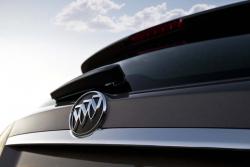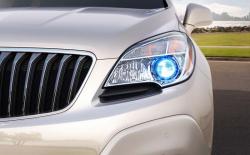 2013 Buick Encore. Click image to enlarge |
Review by Lesley Wimbush, photos by Lesley Wimbush and courtesy GM
Photo Gallery:
2013 Buick Encore
In their quest to attract an increasingly younger demographic, Buick has introduced a new compact premium crossover to the fold, offering utility combined with premium features to the urban buyer.
The 2013 Encore slots in size-wise under the mid-size GMC Terrain (Buick does not have a mid-size crossover of its own) and full-size Enclave. Built in Seoul, South Korea on GM’s Global Small Crossover platform, it will be marketed in North America, Mexico and China.
Apparently, some 52 percent of vehicles sold here in Canada are either cars or small crossovers – a category that GM expects will grow 25 percent by 2017. Buick is hoping to grab a share of that burgeoning market with a utility vehicle for young urban professionals, or empty nesters looking to downsize without sacrificing their creature comforts. The Encore boasts a 5.1-metre turning radius and decent fuel economy, which makes it a more sensible choice for city driving than the typical urban utility behemoth.
Visually, the Encore resembles a shrunken Enclave, but stubbier. Softly rounded, with that enormous waterfall grille, it puts me in mind of a guinea pig grinning through chrome braces.
 2013 Buick Encore. Click image to enlarge |
There’s no shortage of brightwork to complement that grille – and though all models ride on 18-inch rims – premium Encores boast chrome-clad wheels. Sheet metal surfaces are broken up by some interestingly sculpted character lines and culminate in a much more elegantly sculpted rear end than the squarish Terrain’s. Adorning either side of the hood are Buick’s signature portholes – and whether that’s a good thing is entirely subjective.
Under that hood is the familiar Chevy Cruze sourced 1.4L turbocharged Ecotec inline-four, putting out 138 hp and 148 lb-ft of torque. It’s mated to a six-speed automatic transmission. That’s the single available powertrain, but the Encore can be had in either a standard front-wheel-drive, or optional all-wheel-drive configuration.
The Borg-Warner AWD system requires no driver engagement, it’s available on demand. Automatically engaged at launch (when most needed during slippery weather) the system splits power evenly between the front and the rear. If no slippage is sensed, the magnetic clutch disengages over 5 km/h and the drivetrain reverts to FWD, thus conserving fuel.
The Encore is the fourth vehicle in the Buick lineup to feature a turbocharged four-cylinder – and the first non-hybrid Buick to boast fuel consumption ratings of 6.0 L/100 km highway, even lower than the Verano and Regal’s best efforts, which in their most efficient configurations NRCan rates at 6.2. It does so by a number of measures, many of which we’ve seen before in the Cruze Eco. Low rolling resistance tires help overcome the effort expended to resist inertia, and electric power steering reduces, if only by a small amount, the engine power scavenged by a traditional belt-driven system. The Encore also features a high-efficiency alternator, idle speed reduction and deceleration fuel cut-off. Estimated NRCan fuel ratings are 8.2L/100 km city/6.0 highway/7.0 combined for the FWD and 8.8/6.7/7.9 for AWD equipped models.
Of course, Buick’s claim to fame is its reputation for quiet opulence. Buick goes to great lengths to ensure that its “Quiet Tuning” provides a ride that’s one step removed from a sensory deprivation chamber. It does this through a three-step process that reduces sounds at the source, blocks whatever it can from entering the cabin, and absorbing those sounds that inevitably make their way through. Subframes are tuned through MIG-welding and glue to reduce any vibration, and sound-deadening foam insulation is blown into hollow pockets in the body.
The Ecotec engine’s integrated turbo produces very little whine, complemented by an ultra-quiet alternator and electric steering. Mirrors have been designed to resist wind noise and shake. But despite an acoustic laminated windshield, flat wipers and triple door seals – “noise inevitably will find a way to come inside” according to Harry Ng, Product Manager for the Encore. Any that does will be absorbed by several levels of acoustic insulation – or eliminated by the standard Active Noise Cancellation – which outputs counteractive sound waves through the stereo system.











